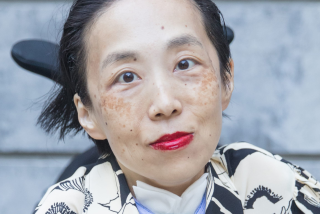Erasing Stephen Hawking’s disability erases an important part of who he was
- Share via
In the days since Stephen Hawking’s death, obituaries have described him as being “confined” or “chained” to a wheelchair, as someone who “overcame” his disability and succeeded in spite of it.
None of those things are true. Stephen Hawking had a disability, and Stephen Hawking used a wheelchair. His work was possible because of those things, not in spite of them.
In fact, Hawking — a tireless advocate for disability rights when he wasn’t busy unlocking the secrets of the universe — viewed those things as a positive.
“My disabilities have not been a significant handicap in my field, which is theoretical physics,” he wrote in Science Digest in 1984. “Indeed, they have helped me in a way by shielding me from lecturing and administrative work that I would otherwise have been involved in.”
From the time he was 20 until his death Wednesday at the age of 76, Hawking suffered from amyotrophic lateral sclerosis. More commonly known as Lou Gehrig’s disease, it is a progressive neurological disorder that prevents the brain from controlling the voluntary muscles throughout the body.
People with disabilities and advocates for disability rights have been particularly chagrined by one image making the rounds on social media: an upright man silhouetted against a backdrop of stars, with an empty wheelchair in the foreground. It has been frequently accompanied by references to Hawking “finally being able to walk among the stars” or being “free” of his wheelchair.
The image makes it seem “like every disabled person dreams of shedding their disability,” said Virginia Knowlton Marcus, the director of legal advocacy for Disability Rights California.
“I think that able-bodied people often see the technology disabled people use as a burden,” she said. “His wheelchair was his tool. He wheeled all over Cambridge. It wasn’t a burden.”
Andrew Gurza, a disability rights awareness consultant and freelance writer in Toronto, said he was disturbed to see Hawking’s disability — a major part of his life and who he was — functionally erased in the drawing.
In a piece for Men’s Health, Gurza, who hosts a podcast about sex and disability called “Disability After Dark,” explained why he was bothered by the image.
“As a fellow wheelchair user, these kinds of depictions, while perhaps well-intentioned, sting,” he wrote. “I wouldn’t want someone to erase my identity as a disabled person in my death, as it is a huge intrinsic part of who I am and how I see the world around me. It is unfair that in order for us to celebrate his life, we feel it necessary to remove a part of who Stephen Hawking was: a disabled man.”
In an interview with The Times, Gurza said using a wheelchair gives you a unique perspective on the world, and that it’s possible Hawking wouldn’t have come up with the theories he did if he hadn’t had a disability.
“His disability probably lent itself to him becoming such a great mind, probably more than most people,” Gurza said. “Maybe [Hawking] wouldn’t have written this book, maybe he wouldn’t have thought about all these things if he weren’t disabled.”
Showing Hawking leaving his wheelchair behind implies that being in a wheelchair is something to escape. But Hawking’s wheelchair didn’t confine him. With a sophisticated onboard computer, it enabled him to work, to travel, to write and to lecture.
Gretchen Schreiber is a professional reader for a production company in Los Angeles, and she has a disability (though not one that limits her mobility). She wrote on Facebook about the troubling implications of sentiments like Hawking being “free of his chair,” describing them as “passive ableism.”
“Wheelchairs are modes of transport and allow people to be part of the community and part of the world, and essentially be free,” Schreiber told The Times. “So to turn it on its head as if it were some sort of prison, confinement — when it’s actually the opposite — is really sad and a misunderstanding of what the disabled community can do and add to the world.”
Disability is about the failure of the environment to be adapted to people with disabilities.
— USC professor Alison Dundes Renteln
In the foreword to a 2011 World Health Organization report on the global state of disability rights, Hawking wrote about a shared moral duty to remove barriers to participation for disabled people. He addressed the United Nations in support of a treaty called the Convention on the Rights of Persons with Disabilities. (It was adopted by the U.N. in 2006, but fell six votes short of being ratified by the U.S. Senate in 2012.)
“He knew that he was a symbol, not only for the pursuit of knowledge about science but for people with disabilities,” said Alison Dundes Renteln, a political science professor at USC who helped with the drafting and implementation of the treaty. She said Hawking wanted everyone to know that people with disabilities could live full lives, just like he had, if they had the right tools and support.
“Disability is about the failure of the environment to be adapted to people with disabilities,” Renteln said: If a person who uses a wheelchair can’t access a scientific laboratory or a library because there aren’t ramps or the aisles aren’t wide enough, that’s the fault of the lab or library, not the wheelchair user.
Hawking spent his last months speaking out against potential cuts to Britain’s National Health Service and working on a lawsuit against Health Secretary Jeremy Hunt.
“Everybody assumes that a disability is a negative or somehow undesirable,” said Knowlton Marcus of Disability Rights California. “Disability is part of the normal, natural human diversity, and if we all could just accept that simple fact, it would be a giant step toward paving the way to more inclusion of people with disabilities. We live in an ableist society that really marginalizes so much human potential.”
A few years ago, Intel gave Stephen Hawking a fully upgraded communication system. He turned down one change: the option to have a less robotic-sounding voice.
Hawking said the synthesized voice he’d used since the 1980s was his voice, and he saw no reason to change it.
Follow me on Twitter @jessica_roy and “like” Los Angeles Times Science & Health on Facebook.
MORE IN SCIENCE
By vibrating the muscles, engineers produce a better prosthetic hand
Evolve or die: Why our human ancestors learned to be social more than 320,000 years ago
Move over, Neanderthals: Our ancestors mated with Denisovans not once but twice, scientists say







